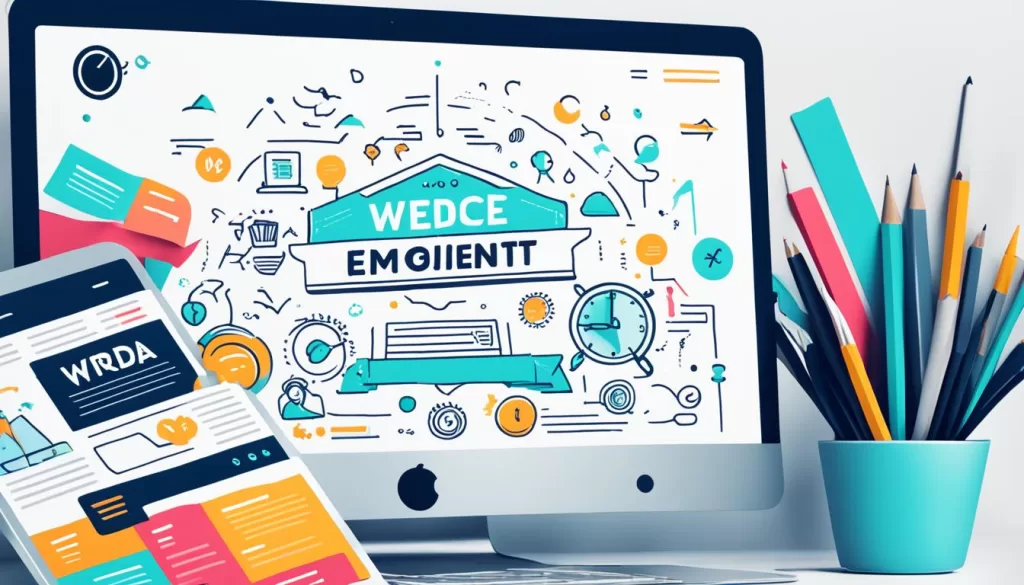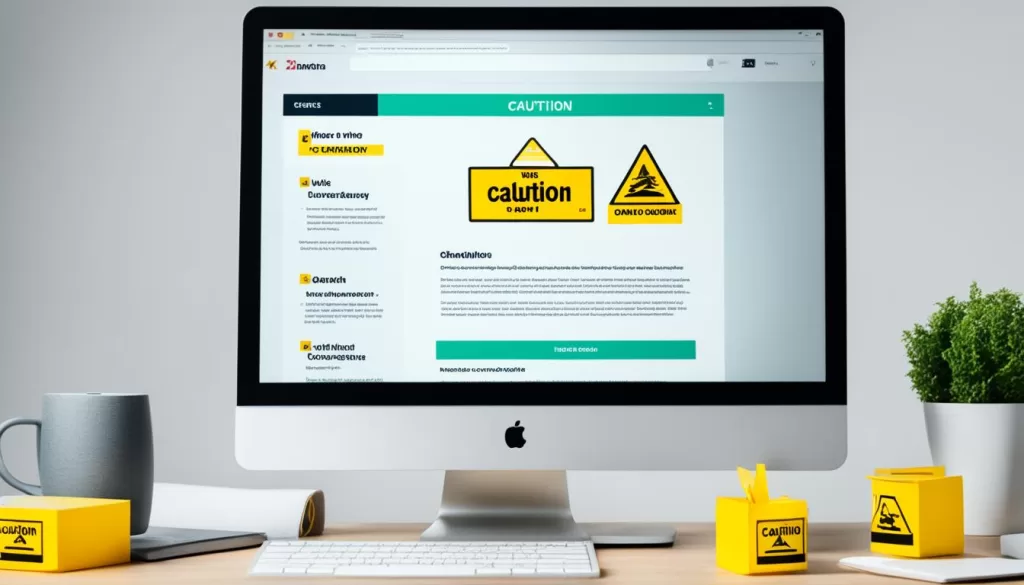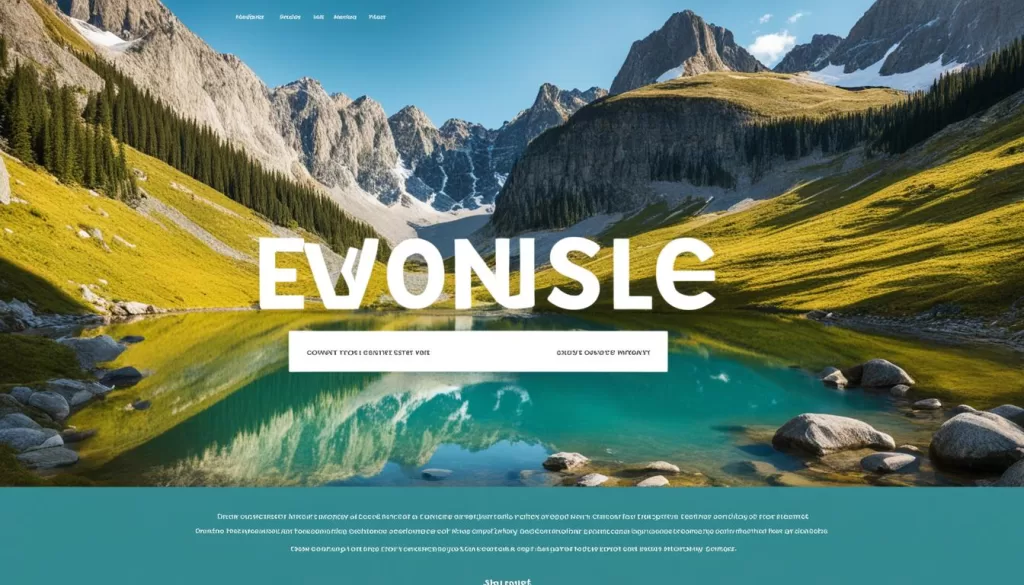Your website is the online face of your business, and it plays a crucial role in attracting and retaining customers. However, if your website is not optimized for user experience, it may be scaring away potential customers. In this article, we will explore seven common reasons why your website is scaring away customers in 2024 and provide tips on how to fix these critical issues to boost your engagement and sales.
Key Takeaways:
- Understand the importance of website optimization for customer retention and conversion rates.
- Identify design flaws and user experience issues that may scare away customers.
- Implement customer retention strategies to improve website performance.
- Enhance the initial engagement on your website with compelling messaging and attractive design elements.
- Clarify your brand’s identity through clear branding and transparency in customer interactions.
Introduction to Website Optimization and Customer Retention
Welcome to the second section of our article, where we will delve into the world of website optimization and customer retention strategies. In today’s digital landscape, having a well-optimized website that provides a positive user experience is crucial for attracting and retaining customers. Additionally, implementing effective conversion rate optimization techniques can significantly improve your website’s performance and ultimately lead to higher customer retention rates.
Website optimization encompasses various aspects, including design, functionality, and content. It involves enhancing your website’s speed, navigation, and overall user experience to ensure visitors have a seamless and enjoyable journey. By prioritizing website optimization, you can create a user-friendly platform that encourages engagement, boosts conversions, and promotes customer loyalty.
When it comes to customer retention, implementing effective strategies is essential to foster long-term relationships and maximize customer lifetime value. By understanding your target audience’s needs and preferences, you can tailor your website to provide personalized experiences that keep customers coming back. From personalized recommendations and loyalty programs to timely communication and exceptional customer support, there are various customer retention strategies you can implement to nurture lasting relationships with your audience.
Throughout this section, we will explore in-depth the significance of website optimization, user experience, conversion rate, and customer retention strategies. Our aim is to equip you with the knowledge and insights necessary to improve your website’s performance and drive the growth of your online business.
To enhance your understanding, let’s take a look at an image that illustrates the concept of website optimization and its impact on user experience and customer retention.
Inadequate Initial Engagement
The first few seconds after a user lands on your website are crucial in determining whether they will stay or leave. To prevent inadequate initial engagement and ensure a positive website first impression, it’s essential to focus on creating an immersive user experience. By incorporating engaging images, attractive design, and compelling messaging, you can capture your visitors’ attention and encourage them to explore further.

Engaging images play a pivotal role in grabbing the attention of your audience. By using visually appealing and relevant images throughout your website, you can create an instant connection and spark interest. Make sure the images you choose align with your brand and evoke the desired emotions or actions from your visitors.
Alongside engaging images, the design of your website should be visually attractive and intuitive. A clean and professional layout can make a significant impact on the overall user experience. Optimize the use of white space, colors, and fonts to create a visually appealing design that enhances readability and navigability.
In addition to imagery and design, compelling messaging is crucial for creating a lasting impression. Craft concise and persuasive copy that clearly communicates your value proposition and resonates with your target audience. Use powerful headlines, subheadings, and bullet points to highlight key information and make it easily scannable for visitors.
By focusing on addressing inadequate initial engagement with engaging images, attractive design, and compelling messaging, you can captivate your website visitors and keep them from being scared away. Next, we will explore how clarifying your brand’s identity can further enhance your website’s effectiveness and customer retention.
Clarifying Your Brand’s Identity
One of the reasons why your website may be scaring away customers is a lack of clarity in your brand’s identity. Your brand’s identity is the foundation of your business, and it shapes how customers perceive and connect with your products or services. To establish a strong brand identity, it is crucial to focus on two essential aspects: hero messages and clear branding.
Hero Messages and Clear Branding
A hero message is a concise and compelling statement that effectively communicates your brand’s core value proposition to your target audience. It encapsulates what sets your brand apart from competitors and why customers should choose your products or services. A well-crafted hero message creates an immediate connection with customers and captures their attention, making them more likely to stay on your website and explore further.
In addition to hero messages, clear branding is vital in establishing a strong brand identity. Clear branding involves creating consistent and recognizable visual elements such as logos, color schemes, typography, and imagery. These elements should align with your brand’s personality and values, creating a cohesive and unified brand image across all touchpoints.
When your hero messages and clear branding work together harmoniously, they create a memorable and distinctive brand identity that resonates with your target audience, building trust and loyalty. A strong brand identity helps customers understand who you are, what you stand for, and what they can expect from your products or services, reducing the likelihood of them being scared away.
Importance of Transparency in Customer Interaction
Transparency is a crucial factor in establishing trust and fostering customer loyalty. When customers visit your website, they expect transparency in how you communicate and interact with them. Transparent customer interaction means being open, honest, and upfront with your customers about your products or services, policies, pricing, and any other relevant information. This transparency creates a sense of reliability and authenticity, increasing customers’ confidence in your brand.
There are various ways to incorporate transparency into your customer interaction. For example, you can provide clear and comprehensive product descriptions, pricing information, and shipping details. Be responsive to customer inquiries and feedback, addressing any concerns or issues promptly and honestly. Additionally, consider sharing customer reviews or testimonials, demonstrating the positive experiences others have had with your brand.

7 Reasons Why Your Website is Scaring Away Customers
In this section, we will dive deeper into the seven reasons why your website may be scaring away customers. These issues can negatively impact your website’s conversion rate, hinder customer experience, and ultimately lead to customer deterrents. It is crucial to identify these website scare factors and take effective measures to improve your website’s performance and customer retention strategies.
- Slow Website Speed: A slow-loading website can frustrate users and drive them away. Optimize your website’s speed to ensure a smooth browsing experience for your customers.
- Outdated Design: An outdated website design can make your brand look unprofessional and untrustworthy. Invest in a modern and visually appealing website design to attract and retain customers.
- Confusing Navigation: Poor navigation can make it difficult for users to find what they are looking for on your website. Simplify your website’s navigation structure and make it intuitive for users to navigate through your content.
- Lack of Mobile-friendliness: With the increasing use of mobile devices, it is crucial to have a mobile-friendly website. Ensure that your website is fully responsive and provides a seamless user experience across different screen sizes.
- Poor User Experience: A website with a poor user experience can drive away potential customers. Ensure that your website is intuitive, easy to navigate, and provides valuable content to enhance the overall user experience.
- Website Design Flaws: Identifying and fixing design flaws such as broken links, inconsistent branding, and outdated graphics are essential for creating a positive impression on your customers.
- Lack of Call-to-Action: If your website does not have clear call-to-action buttons or prompts, customers may struggle to know what action to take next. Ensure that every page of your website has a clear and compelling call-to-action to guide users towards conversion.
By addressing these reasons, you can significantly improve your website’s performance and increase customer retention. Take the necessary steps to optimize your website and provide an exceptional website user experience. Let’s now explore how you can enhance your mobile usability in the next section.

Enhancing Mobile Usability
Responsive Design for a Mobile Audience
Optimizing for Mobile Devices
With the increasing use of smartphones and tablets, it is essential to optimize your website for mobile users. Having a mobile-friendly website is no longer an option, but a necessity to cater to the mobile audience and provide a seamless mobile user experience. To achieve this, responsive design plays a crucial role.
Responsive design allows your website to adapt and display effectively on any device, regardless of screen size or orientation. It ensures that your content is easily readable and navigable, providing a consistent and enjoyable experience for mobile users.
When implementing responsive design, consider the following tips:
- Use a mobile-first approach: Start designing your website with a mobile layout in mind, and then adapt it for larger screens. This approach ensures that your site is optimized for the majority of your mobile audience.
- Utilize fluid grids and flexible images: Design your website using relative units like percentages instead of fixed pixels. This allows your website to automatically adjust and scale based on the screen size. Additionally, optimize your images by using appropriate compression techniques to reduce loading times without compromising quality.
- Streamline navigation and interactions: Simplify your website’s navigation and ensure that buttons, menus, and interactive elements are easily tappable and accessible on mobile devices. Use intuitive icons and clear labels to guide users through your site.
- Focus on readability and legibility: Choose fonts that are easy to read on smaller screens, and ensure there is appropriate contrast between text and background. Additionally, break up content into smaller paragraphs and use headings to improve scanability.
While responsive design is crucial, optimizing for mobile devices goes beyond layout and visual aspects. It also involves improving website performance and tailoring the user experience specifically for mobile users.
To enhance mobile website performance:
- Optimize page load times: Compress and minify your website’s CSS, JavaScript, and HTML files to reduce file sizes and improve loading speed. Optimize image sizes, leverage browser caching, and consider using content delivery networks (CDNs) to deliver content more efficiently.
- Minimize user input requirements: Simplify forms and input fields, reducing the number of required fields and using auto-fill and validation features wherever possible. Mobile users are often on the go and may not have the time or patience to fill out lengthy forms.
- Implement touch-friendly elements: Ensure that buttons and links are large enough and spaced apart to accommodate finger taps accurately. Avoid using hover interactions that do not translate well to touchscreens.
Incorporating mobile-specific design elements:
- Utilize mobile-friendly interactive elements: Leverage features like swipe gestures, scrollable carousels, and expandable menus to enhance the mobile user experience.
- Consider mobile-only content: Tailor your content to suit mobile users by providing easily digestible snippets, summaries, or mobile-exclusive offers.
By implementing responsive design and optimizing for mobile devices, you can ensure that your website caters effectively to your mobile audience, delivering an exceptional mobile user experience and driving engagement and conversions.

Content Quality and Ad-Related Drawbacks
The quality of your website’s content plays a significant role in determining the user experience (UX) and whether visitors stay or leave. High-quality content not only engages users but also enhances your website’s credibility and authority. On the other hand, ad-related drawbacks can negatively impact UX and potentially scare away potential customers. In this section, we will explore the importance of content quality, discuss ad-related drawbacks, and provide tips for creating user-friendly content to engage and retain visitors.
When it comes to content quality, focus on providing valuable and relevant information that addresses the needs and interests of your target audience. Well-written and informative content builds trust and establishes your brand as an industry expert. Consider using images, videos, and interactive elements to make your content more engaging and visually appealing. Remember, high-quality content increases the chances of converting website visitors into loyal customers.

While website ads are a common way to generate revenue, it’s essential to strike a balance between ads and user experience. An overwhelming number of ads or intrusive ad placements can disrupt the user flow, making it difficult for visitors to navigate and consume your content. Annoying ads can create a negative impression and result in higher bounce rates.
To mitigate ad-related drawbacks, consider the following:
- Strategically place ads without compromising the user experience. Avoid placing ads in a way that obstructs content or makes it difficult to navigate your website.
- Ensure that ads are relevant and add value to the user experience. Irrelevant or intrusive ads can frustrate visitors and lead to higher bounce rates.
- Monitor ad performance and user feedback regularly to identify any issues and make necessary adjustments. Keep track of metrics such as ad viewability, click-through rates, and user complaints to optimize ad placements.
Remember, user-friendly content and a balanced approach to ads can help create a positive user experience and improve your website’s engagement and retention rates.
In the next section, we will summarize the key insights discussed throughout this article and provide a call to action for implementing the suggested improvements to enhance your website’s performance and customer satisfaction.
Conclusion
In conclusion, optimizing your website is paramount for improving customer retention, enhancing user experience, and increasing customer engagement and sales conversion. Throughout this article, we have highlighted the importance of addressing the seven reasons why your website may be scaring away customers in 2024.
By taking steps to enhance your website’s initial engagement through captivating imagery, attractive design, and compelling messaging, you can create a positive first impression that keeps customers engaged. Clarifying your brand’s identity using hero messages and clear branding is another crucial aspect that helps build trust and foster customer loyalty.
Furthermore, addressing common website issues such as slow speed, outdated design, confusing navigation, and lack of mobile-friendliness will significantly improve the user experience and ensure your website is accessible to a wide mobile audience. Investing in responsive design and optimizing your website for mobile devices are essential strategies in today’s digital landscape.
Finally, it is imperative to focus on content quality and avoid ad-related drawbacks. Providing user-friendly content that delivers value and eliminating annoying ads will enhance the overall user experience and keep customers coming back for more.
Now that you are aware of the critical factors influencing customer engagement and retention, it’s time to take action. Implement the suggested improvements and optimize your website to create a seamless user experience that attracts, retains, and converts customers. Your website is the face of your business online, and by prioritizing website optimization, you have the power to exceed customer expectations and drive your business forward.
FAQ
What are some reasons why my website may be scaring away customers?
Some common reasons include slow website speed, outdated design, confusing navigation, lack of mobile-friendliness, poor content quality, and annoying ads.
How can I improve my website’s conversion rate and customer retention?
You can improve your conversion rate and customer retention by optimizing your website for a positive user experience, clarifying your brand’s identity, building trust through transparency, and offering mobile-friendly design and content.
How can I make a strong initial impression on my website?
You can make a strong initial impression by using engaging images, attractive design, and compelling messaging that captures the attention of your visitors.
Why is brand identity important for my website?
Establishing a clear brand identity through hero messages and clear branding helps create a strong connection with your target audience and distinguishes your business from competitors.
How can transparency in customer interaction help build trust?
Transparency in customer interaction, such as being upfront about pricing, policies, and processes, can help build trust with your customers and foster customer loyalty.
How can I optimize my website for mobile users?
You can optimize your website for mobile users by implementing responsive design, ensuring your website is mobile-friendly, and enhancing the overall mobile user experience.
How can I improve the quality of my website’s content?
You can improve the quality of your website’s content by creating user-friendly, engaging, and informative content that aligns with the needs and interests of your target audience.
Source Links
- https://www.exposure.com/blog/the-top-11-reasons-people-leave-your-website-and-how-to-fix-them/
- https://www.manobyte.com/growth-strategy/10-ways-your-website-could-be-driving-customers-away
- https://blog.velocity23.com/blog/what-makes-someone-leave-website-reasons-why-traffic-running-away-infographic-10sim



